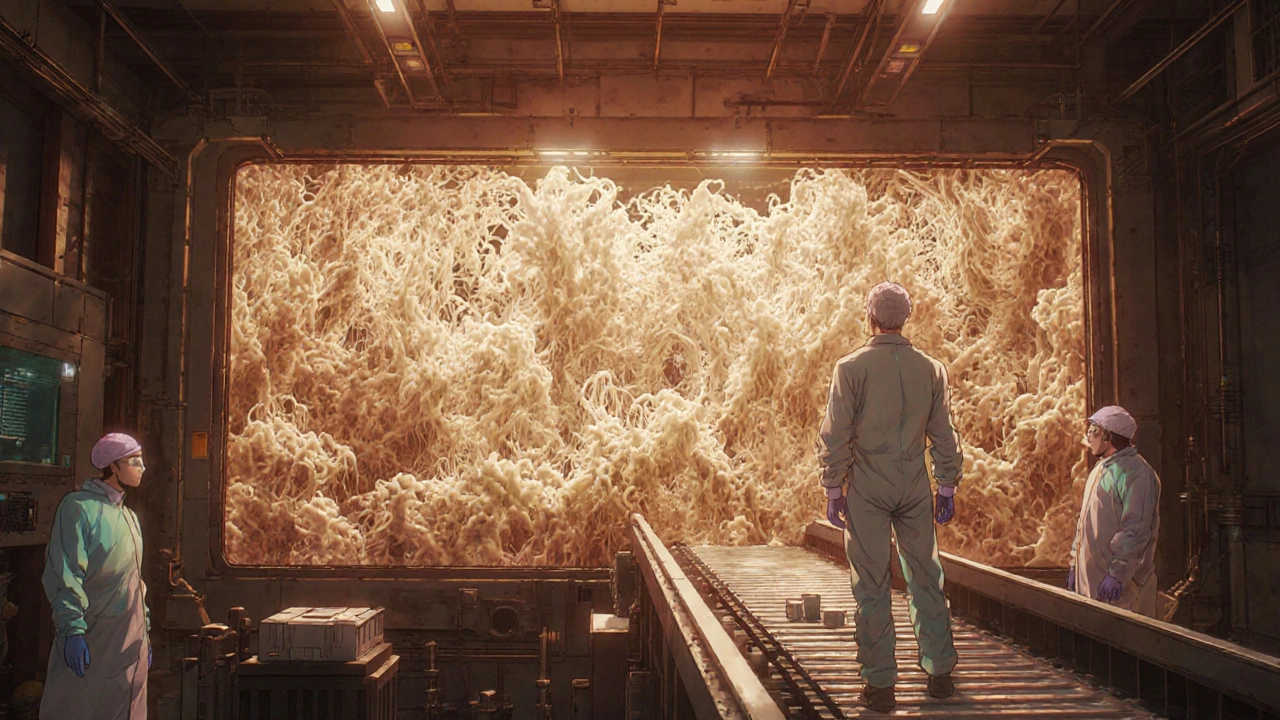Fungal Biotech Feasibility Calculator
Project Assessment
Estimated Profit Margin:
Key Factors:
When you hear the word "fungus," you probably picture a mushroom on a pizza or a damp basement wall. But Fungus is a kingdom of eukaryotic organisms that includes molds, yeasts, and mushrooms with a metabolic toolbox that’s reshaping modern biotechnology. From turning waste into plastic to crafting new medicines, the wave of fungal innovation is set to hit the next decade hard. Below is a practical guide to where the field stands today, what breakthroughs are on the horizon, and how you can stay ahead of the curve.
Why Fungi Matter in Biotechnology
Fungi excel at three things: breaking down complex materials, producing specialized chemicals, and forming robust networks called mycelium. Their ability to digest lignocellulose-plant material most other microbes can’t touch-makes them ideal for converting agricultural leftovers into value‑added products. Moreover, fungi naturally secrete enzymes that catalyze reactions under gentle conditions, cutting energy costs compared to traditional industrial chemistry.
These traits translate into tangible advantages: lower carbon footprints, cheaper feedstocks, and a reduced need for harsh solvents. Companies that tap into fungal platforms can therefore claim both economic and environmental wins-an appealing combo for investors, regulators, and eco‑conscious consumers.
Current Pillars of Fungal Biotechnology
The market today leans on a handful of proven fungal applications. Below each, you’ll see why it works and where the next upgrade is likely.
- Enzyme production: Enzymes are protein catalysts that speed up biochemical reactions, often secreted by fungi like Aspergillus niger. They power laundry detergents, food processing, and bio‑fuel pretreatment.
- Biofuels: Certain yeasts and molds ferment sugars into ethanol, but newer filamentous fungi can produce higher‑energy hydrocarbons (e.g., terpenes) that blend directly with gasoline.
- Bioplastics & Mycelium Materials: Mycelium-Mycelium is the vegetative network of fungal hyphae that can be grown into dense, foam‑like composites-is being molded into packaging, furniture, and building insulation that decompose in weeks instead of centuries.
- Pharmaceutical compounds: Pharmaceutical compounds include antibiotics like penicillin, immunosuppressants, and statins originally derived from fungal metabolism. Modern strain‑engineering pushes yields into commercial‑grade territory.
- Mycoremediation: Mycoremediation is the use of fungi to degrade pollutants such as petroleum hydrocarbons, heavy metals, and pesticide residues, turning contaminated soil into fertile ground.
Emerging Technologies Shaping the Future
While the classic uses are booming, a second wave of high‑tech tools is unlocking capabilities that seemed impossible a few years ago.
- CRISPR‑based genome editing: Researchers are now editing fungal genomes with the same precision once reserved for bacteria. This enables custom pathways for producing rare terpenoids, vitamins, or even biodegradable polymers.
- Synthetic biology platforms: Standardized DNA parts (promoters, terminators) for fungi are being cataloged, allowing rapid assembly of multi‑gene circuits that can switch on/off production cycles based on feedstock availability.
- AI‑driven strain design: Machine‑learning models predict how gene edits will affect yield, shortening the trial‑and‑error loop from months to weeks.
- Continuous fermentation: Instead of batch reactors, companies are moving toward steady‑state bioreactors that keep fungal cultures at optimal growth phases, boosting output by up to 30%.
These innovations are converging on one goal: make fungal processes as predictable and scalable as petrochemical factories.

Scaling Up: From Lab Bench to Industrial Plant
Transitioning a fungal strain from Petri dish to 10,000‑liter fermenter is not just a matter of buying a bigger tank. The challenges are technical, regulatory, and cultural.
- Mass transfer: Mycelial mats can become viscous, limiting oxygen diffusion. Engineers now use spargers and rheology modifiers to keep the broth well‑mixed.
- Contamination control: Fungi share space with bacteria; a single contaminant can outcompete the production strain. Closed‑system bioreactors and rigorous sterilization protocols are becoming standard.
- Regulatory pathways: For food‑grade or pharma products, agencies like the FDA require detailed toxicology data on the host organism. New guidance documents released in 2024 have begun to streamline approvals for genetically‑modified fungi.
- Supply‑chain logistics: Consistent feedstock quality (e.g., corn stover, municipal organic waste) is crucial. Partnerships with agricultural cooperatives are emerging to guarantee low‑cost, season‑agnostic inputs.
Companies that anticipate these hurdles early can shave years off their time‑to‑market.
Future Outlook: Trends to Watch Through 2035
Here are the five trends most analysts agree will define fungal biotech’s next decade.
- Carbon‑negative manufacturing: By coupling mycelium biocomposites with captured CO₂, firms aim to create products that pull more carbon out of the atmosphere than they emit.
- Personalized nutrition: Engineered yeast‑derived fungal proteins can be tailored to individual micronutrient needs, promising a new class of custom supplements.
- Hybrid bio‑inspired materials: Merging fungal mycelium with 3D‑printed polymers yields lightweight, fire‑resistant structures for aerospace and automotive sectors.
- Decentralized production: Small‑scale fermenters (under 500 L) can be placed on farms or in urban warehouses, turning local waste streams into high‑value chemicals on demand.
- Global investment surge: Venture capital funding for fungal startups topped $1.2 billion in 2024 and is projected to double by 2027, signaling mainstream confidence.
All of this points to a world where fungi are not a niche curiosity but a backbone of the sustainable economy.

Quick Checklist for Companies Entering the Fungal Space
- Identify a high‑value target (enzyme, biofuel, material) and map existing fungal pathways.
- Secure a robust, low‑cost feedstock stream.
- Choose a strain with a sequenced genome-preferably one already accepted by regulatory bodies.
- Leverage CRISPR or synthetic‑biology toolkits to boost yields.
- Design a pilot‑scale continuous fermenter before committing to full‑scale production.
- Prepare a comprehensive regulatory dossier early in the development cycle.
Frequently Asked Questions
What makes fungi more sustainable than bacteria for industrial processes?
Fungi can break down lignocellulosic waste-something most bacteria can’t-so they use cheap, abundant feedstocks like agricultural residue. They also secrete enzymes directly into the medium, reducing the need for downstream purification.
Are genetically modified fungi safe for food applications?
Regulatory agencies evaluate each GMO on a case‑by‑case basis. So far, approvals for CRISPR‑edited yeast in baking and malt production have been granted in the US and EU, indicating a growing safety consensus.
How does mycelium‑based packaging compare to traditional plastic?
Mycelium composites are lightweight, provide comparable cushioning, and fully compost within 30‑60 days. They typically cost 10‑20% more per unit, but the carbon‑offset savings often balance the price gap for eco‑focused brands.
Can fungi help clean up oil spills?
Yes. Species like Phanerochaete chrysosporium produce ligninolytic enzymes that degrade hydrocarbons. Field trials in the Gulf of Mexico showed up to 45% reduction in oil concentration after six weeks.
What’s the biggest technical hurdle for fungal biofuel production?
Achieving high titers of fuel‑grade hydrocarbons without toxic by‑products. Advances in metabolic engineering and continuous fermentation are narrowing this gap rapidly.
Take the Next Step
If you’re convinced that fungus biotechnology could reshape your product line or research agenda, start with a feasibility study. Map out raw material availability, sketch a small‑scale fermentation process, and reach out to a university lab experienced in CRISPR fungal editing. The sooner you prototype, the faster you’ll learn where the real opportunities-and roadblocks-lie.
